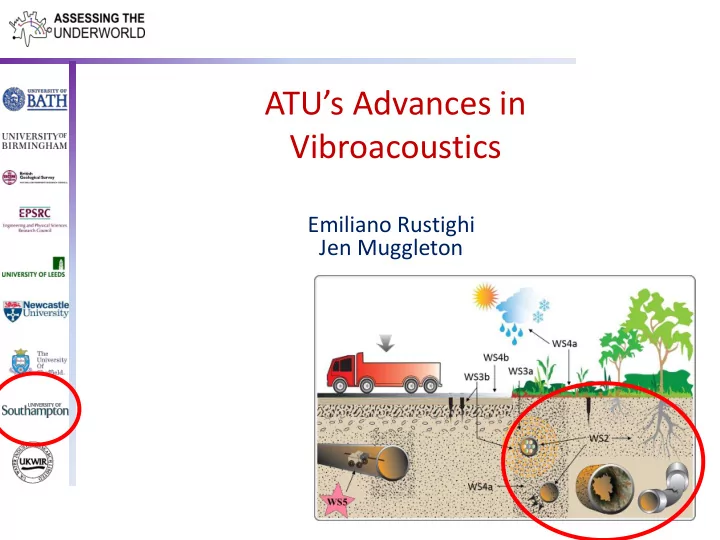

ATU’s Advances in Vibroacoustics Emiliano Rustighi Jen Muggleton
Objectives • To use a pipe vibration method to assess the condition of buried pipework • To investigate a variety of ground excitation methods to interrogate both the ground and the buried infrastructure • To explore a tree excitation method to determine the location of tree roots in order to identify areas of pipe network at risk of damage 2
Pipe Excitation method: Background • When pipe is excited, wave propagation in the pipe mirrored at the ground surface and the run of the pipe can be determined from ground vibration contours Pipe wavespeed 35Hz 8 10 6 5 4 2 0 Soil wavespeed 0 -2 -5 Phase of ground surface response -4 above an MDPE pipe -10 laid under grass 3 -6 -6 -4 -2 0 2 4 6
Pipe excitation: Detection of holes and cracks -20 20 -25 18 • Reflections from 16 Axial distance along pipe, x(m) -30 pipe end discontinuities in pipe 14 (bends, holes, cracks) -35 12 will manifest as more -40 10 or less subtle changes -45 8 in ground surface 6 -50 32mm hole response 4 -55 • Monitor changes over 2 -60 time -2 0 2 Lateral distance from pipe, y(m) Magnitude of ground surface response above an MDPE pipe laid under grass 4
Pipe excitation: Assessing soil condition 19Hz 12 • Changes in the soil will also 0 10 affect ground surface -5 8 response: wave reflections = Axial range (m) -10 peaks in magnitude 6 -15 • Interactions between ground -20 4 and buried infrastructure are -25 complex 2 -30 0 -2 0 2 Lateral distance from excitation location (m) change in soil type 5
In-Pipe Excitation • Recent change in UK legislation • Local excitation/assessment • Source Localisation: Techniques well developed 6
We have now proven that we can use surface response to assess pipes We can now acoustically excite a pipe from inside
Near-surface wavespeed estimation • Array of sensors focused on the surface only • Max in std Apodization: comi Type: DAX 0 0.5 Depth (m) 1 1.5 2 0 1 2 3 4 5 6 Horizontal Position (m)
DA Signal Processing Uniform Stacking Apodized Stacking 0 0 1 1 0.5 0.5 Depth (m) Depth (m) 1 0.5 1 0.5 1.5 1.5 2 0 0 2 0 1 2 3 4 5 6 0 1 2 3 4 5 6 Horizontal Position (m) Horizontal Position (m) Phase Coherence Imaging Sign Coherence Imaging 0 1 0 1 0.5 0.5 Depth (m) Depth (m) 1 0.5 1 0.5 1.5 1.5 2 0 2 0 0 1 2 3 4 5 6 0 1 2 3 4 5 6 Horizontal Position (m) Horizontal Position (m) Coherence Factor Map Istantaneous Phase Weight 0 1 0 1 0.5 0.5 Depth (m) Depth (m) 1 1 0.5 0.5 1.5 1.5 2 0 2 0 0 1 2 3 4 5 6 0 1 2 3 4 5 6 Horizontal Position (m) Horizontal Position (m) 9
We can now automatically detect near-surface wavespeed We have now reduced data analysis time and interpretation time
Crack Detection I • MASW/MISW 𝑔 - 𝑙 spectra: MISW adds a fictitious periodicity which manifests in the spectral image • Extract information regarding location and depth of the cracking. MISW MASW 11
Crack Detection II • Use of wave decomposition method: direct and reflected waves amplitudes and phase • The resonances of the reflection coefficient and the cut-offs of the transmission coefficient are associated with the depth of the crack. • The phase of the direct and of the reflected wave gives an indication of the location of the crack with respect to the reference point. 12
We can now assess crack presence from MISW/MASW We can now locate and characterise cracks from reflections
Buried Tree Root Lab Experiment • Simulated root embedded in sand – Experiments and Numerical models – Flexural & axial waves studied – Work to date shows that roots can potentially be detected at ground surface using this method ground response (axial excitation) Instrumented root model buried in the sandbox 14
Tree Root Mapping: Field Experiments • Simulated Root buried at UoS 15
Tree Root Mapping: Field Experiments • Simulated Root buried at UoS • Distinct signature on ground surface vibration responses 16
We can now locate a buried root
Recommend
More recommend